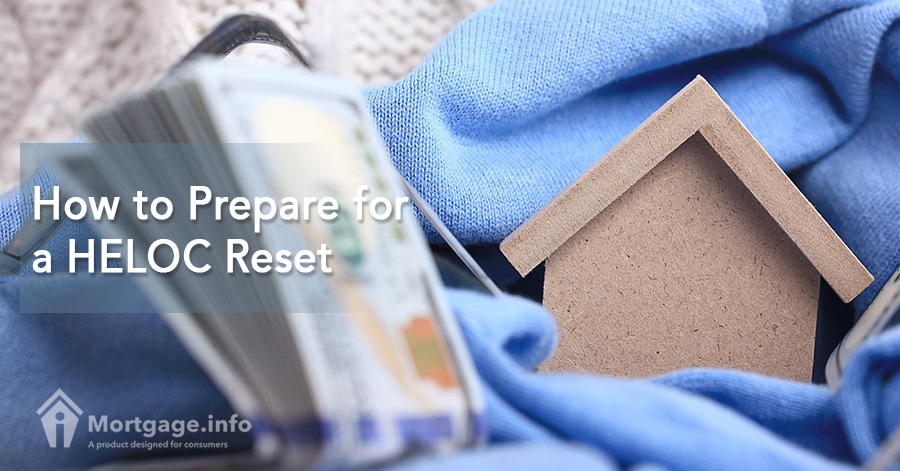
If you are like millions of other Americans, you may be about to enter a HELOC reset. Just what does that mean? Remember that HELOC you took out around 10 years ago? It’s about to reset, meaning your payments are about to skyrocket.
Get Matched with a Lender, Click Here.
This may not be something you want to think about, but it’s reality. You get 10 years of available funds to do with what you please. During that time you were able to make interest only payments. Now that the draw period is up, you are in the repayment period.
The repayment period means you owe principal and interest payments. It also likely means you have an adjustable rate. Your payment could change monthly. What does this mean for your budget? How do you prepare? We provide some helpful tips below.
Know What You Have
First, it’s time to pull out those old mortgage documents. The pieces of information you want to know are:
- The reset date of your HELOC
- How the outstanding loan will be amortized
- How the rate will adjust
Knowing these pieces of information can help you prepare yourself for the HELOC reset. It’s also a good time to determine just how much money you have outstanding. Just because you were given a $50,000 line of credit, for example, doesn’t mean you used all of it. You may have even paid some of it down as you went along during those 10 years.
The bottom line is you need to know what you owe and how you will pay it back.
Once you know the potential payment, it’s time to decide between one of the following remedies.
Keep Your HELOC
Your first option and possibly the simplest is to just keep the HELOC. Of course, don’t make this decision lightly. Understand what you have at stake. Talk to your lender to find out the worst case scenario regarding your payments. Just what will they increase to? Compare that payment to your budget. Can you comfortably afford it? Don’t think of today only – consider the next 20 years as that’s likely how long the HELOC will be amortized.
What are your plans for the next 20 years? If retirement is in your near future, keep that in consideration. Do you want a mortgage payment during that time? If you might change jobs or you think you will go from 2 incomes down to 1 for some reason, think about how the higher payment will affect you.
Click to See the Latest Mortgage Rates.
Refinance Your HELOC
If keeping your HELOC isn’t feasible, you may want to refinance it. How you refinance it depends on your situation. First, you’ll need your home’s value to support the loan amount. It doesn’t help if you are upside down. If you have the value, you can likely refinance into one of the following:
- New HELOC – If you want to keep rolling with the HELOC option, you can try for another one. This will give you another 10 years of a draw period. Think long and hard before you do this, though. You keep putting off the inevitable – paying off the line of credit.
- 2nd mortgage – Refinancing into a 2nd mortgage with a fixed rate can help you stay focused on paying the loan off entirely. You might even be able to convert it into a fixed rate second mortgage without a lot of work with your existing lender.
- Cash out refinance –If you owe less than 85% of your home’s value with your first mortgage and HELOC, you may able to combine them into one mortgage. The cash-out refinance could pay off your HELOC, putting it all in your first mortgage.
Of course, you’ll need to determine which option works for you and which you can afford. Taking a new HELOC might be the riskiest decision if you cannot commit to paying the principal down even during the draw period. The second mortgage and cash-out refinance help you eliminate the HELOC, while helping to put you into a position where you could pay your debt off.
Pay Off Your HELOC
The best thing you could do, but not many people can afford, though, is pay off your HELOC. Depending on your outstanding balance, you may have the money to just pay it off. Even if you were saving the money for something else, it may make sense to pay the HELOC off and avoid the interest charges you would pay over the next 20 years.
It all comes down to looking at the big picture. If you have the cash now, consider how much you would save by paying it off now. 20 years of interest could end up costing you thousands of dollars. If you can part with the cash now, it may make sense to just pay it off, knowing that you have the equity in your home should you ever need to tap into it again in an emergency.
A HELOC reset doesn’t have to be as scary as it sounds. You just have to be prepared. Don’t just wait and see what happens – take a proactive approach. See which option makes the most sense not only now, but well into the future too. You want to make a financial decision that will pay off in the long run rather than one that just ‘gets you by’ today.
